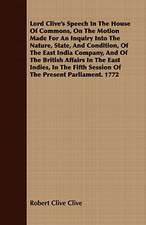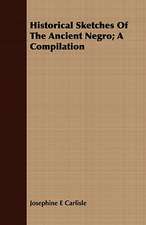History and Film: A Tale of Two Disciplines
Autor Dr. Eleftheria Thanoulien Limba Engleză Hardback – 17 oct 2018
| Toate formatele și edițiile | Preț | Express |
|---|---|---|
| Paperback (1) | 239.59 lei 43-57 zile | |
| Bloomsbury Publishing – 17 oct 2018 | 239.59 lei 43-57 zile | |
| Hardback (1) | 774.53 lei 43-57 zile | |
| Bloomsbury Publishing – 17 oct 2018 | 774.53 lei 43-57 zile |
Preț: 774.53 lei
Preț vechi: 990.89 lei
-22% Nou
Puncte Express: 1162
Preț estimativ în valută:
148.25€ • 161.09$ • 124.61£
148.25€ • 161.09$ • 124.61£
Carte tipărită la comandă
Livrare economică 21 aprilie-05 mai
Preluare comenzi: 021 569.72.76
Specificații
ISBN-13: 9781501340789
ISBN-10: 1501340786
Pagini: 296
Dimensiuni: 152 x 229 x 24 mm
Greutate: 0.56 kg
Editura: Bloomsbury Publishing
Colecția Bloomsbury Academic
Locul publicării:New York, United States
ISBN-10: 1501340786
Pagini: 296
Dimensiuni: 152 x 229 x 24 mm
Greutate: 0.56 kg
Editura: Bloomsbury Publishing
Colecția Bloomsbury Academic
Locul publicării:New York, United States
Caracteristici
Cinema is a dominiant form of how people view and portray history, making film theory one of the main forms of historiography
Notă biografică
Eleftheria Thanouli is Assistant Professor in Film Theory at the Film Department at Aristotle University of Thessaloniki. She received her Ph.D. from the University of Amsterdam in 2005. She is the author of Post-Classical Cinema: An International Poetics of Film Narration (2009).
Cuprins
Table of ContentsAcknowledgmentsPrefaceIntroduction: History and Film in Parallel OrbitsPart I: Historical and Theoretical QuestionsChapter 1: The Archaeology of the Debate: Cinema and Literature as Analogies for HistoryChapter 2: The Problem of Medium SpecificityChapter 3: The Theory and Practice of HistoryPart II: History on Film: Narrating and Explaining the PastChapter 4: The Poetics of History and the Poetics of the Historical FilmChapter 5: The Representation of History in the Fiction FilmChapter 6: The Representation of History in the DocumentaryConclusion: Filmic History in the Twentieth Century: a Successful Performance of FailureBibliographyIndex
Recenzii
A deft and authoritative book with great case studies (especially for those interested in cinematic representations of war), this book should define the film/history debate for years to come. Summing Up: Essential.
Provides the reader with a selected literature review of some of the important works that engage with the intersection of the two disciplines. Moreover, it assembles a taxonomy for the analysis of historical films, both fiction and nonfiction, that may prove useful to students of film.
In my many years of work in this field, I can think of no other study that involves this level of intellectual sophistication in both theories of history and of the visual media, and certainly none which has grappled so successfully with the contentious issues surrounding the question of rendering the human past on screen.
A comprehensive and rigorous study, Thanouli's fine work enriches our understanding of the historical film as a powerful agent of contemporary thinking about the past. Bringing sophisticated readings of historiography and film theory together, Thanouli critically integrates the two disciplines in a way that will undergird future research. A major scholarly accomplishment.
Eleftheria Thanouli's new book reconceptualizes and reframes one of the most vexing questions in the history of film studies - that of the relationship between written and visual narratives. The scope of History and Film: A Tale of Two Disciplines extends and enriches the semantics of the field as established by André Bazin, Marc Ferro, Robert Rosenstone, and Hayden White. Yet it goes further by incorporating new problematics and fresh approaches which make it the most innovative contemporary contribution to the study of filmic history by addressing the representation of history in historical films, fiction film, and documentary and by exploring dimensions of historical emplotment in various written narratives. From the early Soviet experiments to contemporary imaginative narratives, Thanouli's book investigates thoroughly and conclusively the complex relations between narrative and visual forms and re-interprets their links and disjunctures. It will be the study for standard reference for many years to come.
Provides the reader with a selected literature review of some of the important works that engage with the intersection of the two disciplines. Moreover, it assembles a taxonomy for the analysis of historical films, both fiction and nonfiction, that may prove useful to students of film.
In my many years of work in this field, I can think of no other study that involves this level of intellectual sophistication in both theories of history and of the visual media, and certainly none which has grappled so successfully with the contentious issues surrounding the question of rendering the human past on screen.
A comprehensive and rigorous study, Thanouli's fine work enriches our understanding of the historical film as a powerful agent of contemporary thinking about the past. Bringing sophisticated readings of historiography and film theory together, Thanouli critically integrates the two disciplines in a way that will undergird future research. A major scholarly accomplishment.
Eleftheria Thanouli's new book reconceptualizes and reframes one of the most vexing questions in the history of film studies - that of the relationship between written and visual narratives. The scope of History and Film: A Tale of Two Disciplines extends and enriches the semantics of the field as established by André Bazin, Marc Ferro, Robert Rosenstone, and Hayden White. Yet it goes further by incorporating new problematics and fresh approaches which make it the most innovative contemporary contribution to the study of filmic history by addressing the representation of history in historical films, fiction film, and documentary and by exploring dimensions of historical emplotment in various written narratives. From the early Soviet experiments to contemporary imaginative narratives, Thanouli's book investigates thoroughly and conclusively the complex relations between narrative and visual forms and re-interprets their links and disjunctures. It will be the study for standard reference for many years to come.























